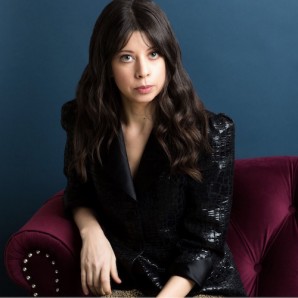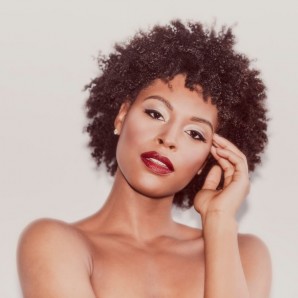No make-up company has a more storied history firmly ensconced in New York showbiz.
NIAN FISH INTERVIEW
Nian Fish, creative director of KCD, has been, for decades, a pivotal figure in the fashion world, assembling and producing fashion shows that have become cultural benchmarks unto themselves, such as Calvin Klein’s 1994 show which saw Mark Wahlberg’s star rise—among other things—as he strutted underwear-clad down the runway.
Her imprint on the image of the industry has taken on another shape by way of her work as chairperson of the Council of Fashion Designers’ Health Initiative, which seeks to promote awareness of eating disorders and spur dialogue about healthy body image among runway models. Her work with the CFDA is giving way to a new online project due to go live in April 2013, featuring a series of short films. But, as this conversation with TWELV shows, in Fish’s life the common threads between fashion and cinema stream beyond video.
Could you tell me a bit about your childhood and perhaps any moment that was a hint of your future career pursuits?
The first thing is that I consider fashion a theatre. We traveled all around the world. My father was in the Army and at one point—which I think is the most crucial point in my life—he left my mother and he didn’t come home for months. My mother had to earn a living and eventually we had to come to New York to work. What I loved so much about New York were all of the different races. There were the Jews, the Puerto Ricans, the Chinese, the Koreans, the Hawaiians; there were the Irish, the Italians. At 10, I started gathering these people who had different talents like the Chinese violinist and the Eurasian hula dancer, who passed for Hawaiian. I would style them, charge 25 cents for admission, and we’d perform in the lobby of my little tenement. I didn’t realize the fashion part of it until just now—but a big part of it was making sure they looked good; refining their characters to make them look more “Hawaiian” or more “Puerto Rican”.
Amazing. So when was this, the 50s?
This was 1960.
So 25 cents was quite a bit of money.
I know! The funny thing is that we were middle class until my parents split up. I started going to this upper-middle-class, Jewish, very liberal camp. My friends were very well educated and I wanted to keep up with them. I felt in order to be loved by them, I had to have a good wardrobe. My aunt’s clothes, which were hand- me-downs, were no longer working for me. I wasn’t even embarrassed about it until I met these friends. What the camp started for me was that I began to lie about where I lived and I started to steal clothes so that I could keep up. It’s funny about acceptance and what you’d do to be accepted. Fashion as a business is all about being loved. You become your own marketing vehicle by what you wear. You go to a young art opening and everyone’s got the flannel shirt or the vintage this. They’re dressed down but it’s all about fashion. The people are saying “I’m cool, I’m a New Yorker; I don’t care about designer clothes but I’m going to look independent.” But at the same time, there’s the indie look and in that way, it’s a tribal acceptance.
It’s an indicator of where you see yourself.
It’s an indicator of where you see yourself and what tribe you are. I think acceptance comes a lot from ap- pearance in our universe.
Literally and figuratively. So, you grew up on the Lower East Side. Describe, in one word or phrase, the LES of your childhood.
Melting pot.
Describe the LES of the present.
Cooly gentrified.
If you were to assemble a cast of figures from movies into a fashion show, who would be walking in it? Who would follow whom?
Jimi Hendrix, the way he looked in the Woodstock documentary. Elizabeth Taylor in Butterfield 8. George Harrison, as in the Scorcese documentary, how he looked in the mid-70s. Audrey Hepburn, in Funny Face, in her beatnik look. The blind samurai in Zatoichi Meets Yojimbo. Ziyi Zhang in Memoirs of a Geisha—so elegant. Uma Thurman in Henry and June. Faye Dunaway and Warren Beatty in Bonnie and Clyde. Paul Newman in Cool Hand Luke. And Bob Dylan in the documentary Don’t Look Back.
I hear you’re writing a screenplay about your parents’ life. Could you tell me a bit about that?
Yes, I’m writing it, filming it and will be directing it. The project is going into its seventh year. I’m funding it myself. My mother is Japanese and Chinese. She comes from a very well-to-do family. How they got their money was from businesses in China that invested in the first Chinese restaurants in Japan. As for my father, the term “white trash” wasn’t used in those days but he would be called “hillbilly”. His mother was from Georgia and played the spoons. His father was a railroad and factory worker, so they were truly working class. The documentary, the story, is about them: two different classes, two different races coming together, my mother coming to the country without speaking English and what that meant; my father’s philandering and what that meant. Then there’s the story of my father leaving my mother, him abandoning us, and my mother and I moving to New York.
But what happened after that is that my father started robbing banks. He went missing and I tried to find him, but I didn’t know he was in jail for 10 years. He got caught after the fourth bank heist and became known as the “Kissing Bandit”. It took a while before my father would talk about his criminal history. The other thing is that he and my mother had this black market business right after World War II and during the Korean War. They would sell cigarettes and mayonnaise. Mayonnaise was a hot commodity after the war and I’ll never forget about my maid getting fired for stealing mayonnaise. But my parents had a good little business going and probably built up a pretty good nest egg. Hey, they were Bonnie and Clyde! Another thread.
Written by ANNE SZUSTEK
Photography CAMERON KRONE
Makeup by KEIKO HIRAMOTO @Bryan Bantry Agency.
Production, Casting ALISON NGUYEN.
Edited by NANAMI INABA
related posts
Alcone 65th Anniversary @Capitale: Interview with CEO Maria Stewart
Ikemen #35: Zaher Saleh
IKEMEN (ē´k´mɛn): Japanese Slang
"REALLY, REALLY, RIDICULOUSLY GOOD LOOKING PEOPLE"
Interview: Neurosurgeon-turned-Artist Keith Kattner on the Surgery of Classical Painting
Dr. Keith Kattner does not have the typical background one would expect of a successful neurosurgeon.
New Type #27: Nika Tang Interview
San Fransisco-based designer Nika Tang has emerged as boldly committed to her ideology as to her pieces. Her namesake brand centers...
Interview: Becky Donnelly's Fashion Creatures
Quirky girl from Dublin with a penchant for drawing fantasy creatures relocates to London after art school.
Kaimin Interview & S/S18 "Slut from the Future" Presentation @ the Top of the Standard
Pulsing with a heavy beat and hazy with a deep rouge glow, the Top of the Standard is as glamorous a place to be as ever. And tonight it is packed with partygoers.
Yasmina Alaoui Interview & Opera Gallery Exhibition
Yasmina Alaoui burst onto the international arts scene in 2003 with "Tales of Beauty," a collection of nude...
Søren Solkær Interview
Stepping out of a cab into the urban symphony of Midtown, the entryway to The Quin Hotel was easy to spot— with classic architecture and...
Kyra Ross of Mona Liza Studios Interview
TWELV sat down with the charismatic Kyra Ross, founder of Mona Liza Studios which falls under his larger moniker "...
Ira Sumbaeva Interview
TWELV sits down with model Ira Sumbaeva to give a glimpse into the story of the cutest Belarusian...
Benjamin Shine Interview: Master of Tulle
Benjamin Shine is an award-winning international artist whose work stretches across industries from fashion...
New Type #25: Mémère – Sarah LeBlanc Interview
Upon arriving to the Mémère studio, it felt like stepping from the bustle of New York City...
IKEMEN #34: GABRIEL LIBERTY
IKEMEN (ē´k´mɛn): Japanese Slang
"REALLY, REALLY, RIDICULOUSLY GOOD LOOKING PEOPLE"
NEW TYPE #23: ANE AMOUR – IYALA ANNE INTERVIEW
“Introducing a talented designer giving sophisticated femininity an edge”
NEW TYPE #22: Allina Liu INTERVIEW
Born and raised in New York City– we could also add, "in love with”– Allina Liu is a refreshing womenswear designer, who questions the...
NEW TYPE #21: Kendall Miles INTERVIEW
“My passion is shoes. Kendall Miles shoes are beautiful, alluring and handcrafted in Italy: the perfect pair for the woman who knows who she is and where she wants to go.”
NEW TYPE #20: Shahista Lalani INTERVIEW
"Introducing an emerging designer creating captivating leather fashions."
NEW TYPE #19: PAMPLEMOUSSE - Danica Zheng Interview
“Introducing a dedicated, innovative designer to awaken every woman’s inner voice.”
NEW TYPE #18: BOOM DONE SHOP - LIAM BERGIN INTERVIEW
“Introducing the new hot British ethical apparel brand BOOM DONE SHOP”
NEW TYPE #17: NAMILA - NAN LI AND EMILIA PFOHL INTERVIEW
NAMILIA was founded in 2015 by Berlin based designers Nan Li and Emilia Pfohl. The duo met while attending University of the Arts Berlin.
Isabel Dupre Interview
Isabel Dupre Interview is now available!
Check inside for the Full Page Interview.
IKEMEN #33: DANIEL VIEDMA
IKEMEN (ē´k´mɛn): Japanese Slang
"REALLY, REALLY, RIDICULOUSLY GOOD LOOKING PEOPLE"
Judi Harvest INTERVIEW
“We’re all bees, we need to dance more and always search for beauty,” Judi Harvest proclaims.
BEHIND THE SCENES #4: Nicola Formichetti
TWELV's Behind the Scenes takes a step back and visits the masterminds behind the camera.
IKEMEN #32: TERRY DOE
IKEMEN (ē´k´mɛn): Japanese Slang
"REALLY, REALLY, RIDICULOUSLY GOOD LOOKING PEOPLE"
Name: TERRY DOE
NEW TYPE #16: LINDER - SAM LINDER AND KIRK MILLAR INTERVIEW
“Introducing a new generation of quick and fresh minded designers”
IKEMEN #31: CORNELIUS LOY
IKEMEN (ē´k´mɛn): Japanese Slang
"REALLY, REALLY, RIDICULOUSLY GOOD LOOKING PEOPLE"
Takarazuka CHICAGO Cast Members Interview
“All Japanese, All Women, All that Jazz! We interviewed three cast members of Takarazuka CHICAGO who preformed in the Lincoln Center Festival in 2016.
Sean O’Pry EXCLUSIVE INTERVIEW "Good Ol’ Georgia Boy”
SEAN O’PRY EXCLUSIVE INTERVIEW
"GOOD OL’ GEORGIA BOY”
R.I.P. Bill Cunningham
Bill Cunningham, Iconic Street Style Photographer, Passes away at 87
NEW TYPE #14: Alida Boer - Alida Boer Interview
TWELV Magazine sat down with Alida Boer in NYC to get to know the designer and better understand the intricacies of her designs and company’s mission.





































